You can relieve your dog's joint discomfort through various novel approaches. Start with nutritional supplements like glucosamine and omega-3 fatty acids to support joint health. Consider physical therapies such as hydrotherapy and massage to improve mobility and reduce stiffness. Acupuncture can also provide pain relief and enhance overall well-being by stimulating endorphins. Innovative medications, like monoclonal antibodies, target inflammation without the side effects of traditional NSAIDs. Ultimately, managing your dog's weight and diet can greatly alleviate joint stress. There's so much more to discover, ensuring your furry friend stays happy and comfortable.
Understanding Canine Joint Pain

Canine joint pain can be a heartbreaking issue for dog owners. It's tough to watch your furry friend struggle to move or play like they used to. This discomfort often stems from conditions like arthritis, hip dysplasia, or injuries. Understanding the causes can help you recognize the signs early and seek appropriate care.
You might notice your dog limping, hesitating to jump, or showing reluctance to go for walks. These behaviors signal that they're in pain. Joint pain may also lead to changes in their mood, such as increased irritability or withdrawal from activities they once enjoyed.
Age, breed, and weight are pivotal factors in determining a dog's susceptibility to joint pain. Larger breeds often experience more severe joint issues due to their size and weight, while older dogs are more prone to degenerative conditions.
Regular vet check-ups are indispensable for monitoring your dog's joint health. Early detection can markedly improve their quality of life. By staying observant and informed, you can guarantee your dog receives the right support to manage their joint discomfort effectively.
Nutritional Supplements for Relief
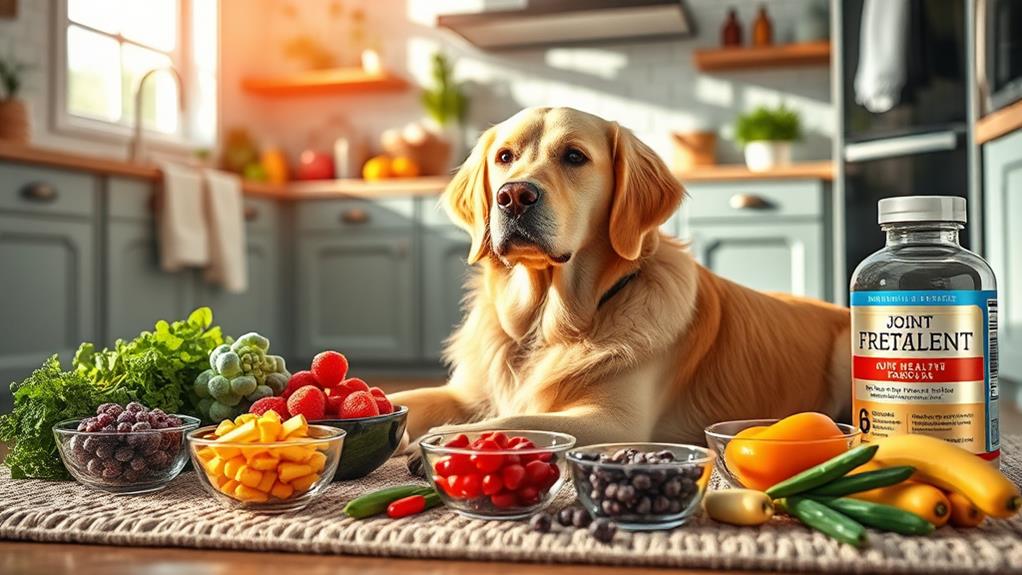
Evaluating nutritional supplements can be a game changer in alleviating your dog's joint discomfort. These supplements can help reduce inflammation, improve mobility, and promote overall joint health. Four popular options you might wish to evaluate:
- Glucosamine: This natural compound helps rebuild cartilage and can reduce pain and inflammation in joints.
- Chondroitin: Often paired with glucosamine, chondroitin helps maintain cartilage structure and may slow its breakdown.
- Omega-3 Fatty Acids: Found in fish oil, these fatty acids are known for their anti-inflammatory properties, which can ease joint pain and stiffness.
- Turmeric: This spice contains curcumin, which has powerful anti-inflammatory effects that can help reduce joint discomfort.
Prior to introducing any supplements, it's crucial to consult your veterinarian. They'll help you choose the right products and dosages for your dog's specific needs. By incorporating these nutritional supplements into your dog's routine, you could see significant improvements in their joint health and overall quality of life. Remember, a proactive approach is key to keeping your furry friend comfortable and active!
Physical Therapy Techniques
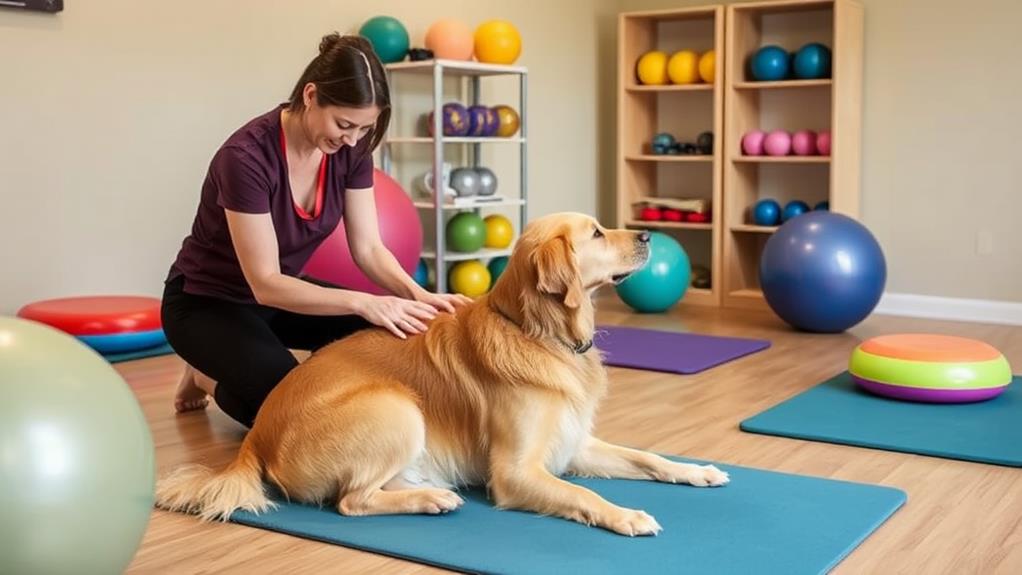
When it comes to easing your dog's joint discomfort, physical therapy techniques can make a significant difference. These methods focus on improving mobility, reducing pain, and enhancing overall quality of life for your furry friend.
One effective technique is hydrotherapy, which involves exercising your dog in warm water. The buoyancy reduces pressure on the joints while allowing for gentle movement, helping to strengthen muscles and improve flexibility. You might also consider range-of-motion exercises, where you gently move your dog's limbs to maintain joint function and prevent stiffness.
Massage therapy can be another beneficial option. By applying gentle pressure to your dog's muscles, you can increase blood circulation and alleviate tension. If you're not comfortable performing these techniques yourself, a certified canine massage therapist can help.
Additionally, you might explore the use of therapeutic ultrasound, which uses sound waves to promote healing and reduce inflammation. Always consult with your veterinarian before starting any physical therapy regimen, as they can guide you in choosing the best approach for your dog's specific needs. Combining these techniques with proper care can lead to a happier, more active life for your canine companion.
Acupuncture and Its Benefits
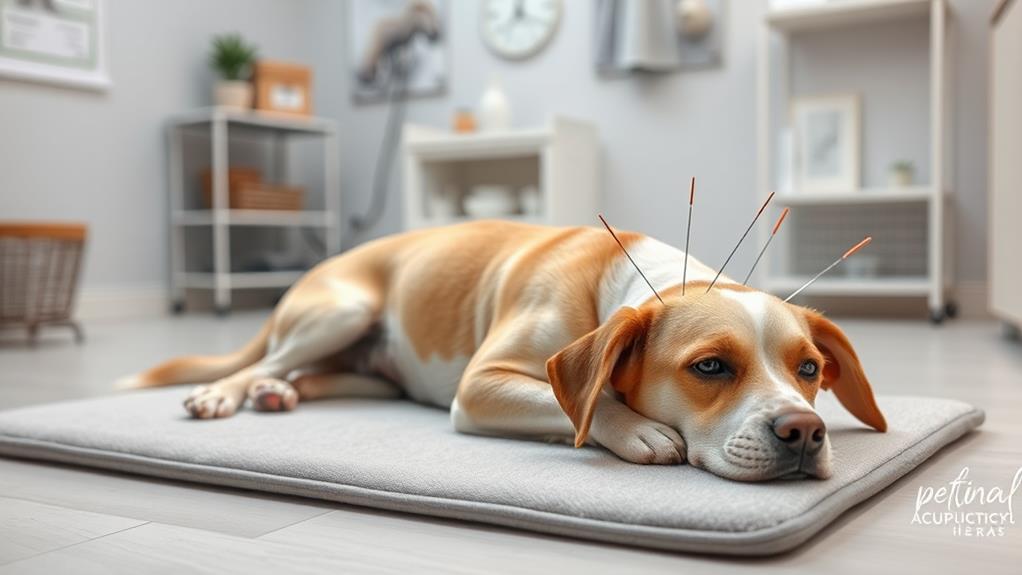
As you explore various methods to alleviate your dog's joint discomfort, acupuncture emerges as a compelling option. This ancient practice, rooted in Traditional Chinese Medicine, involves the insertion of fine needles into specific points on your dog's body. Many pet owners have reported positive outcomes, and here's why you might consider it:
- Pain Relief: Acupuncture can help reduce pain by stimulating the release of endorphins, which can soothe your dog's discomfort.
- Improved Mobility: By addressing inflammation and promoting blood circulation, acupuncture can enhance your dog's range of motion, making everyday activities easier.
- Minimal Side Effects: Compared to some medications, acupuncture typically has fewer side effects, making it a safer alternative for long-term use.
- Holistic Approach: This technique not only targets joint issues but also promotes overall well-being, supporting your dog's emotional and physical health.
If you're curious about how acupuncture can fit into your dog's care plan, consider consulting with a veterinarian experienced in this practice. It might just be the relief your furry friend needs!
Innovative Medications and Treatments
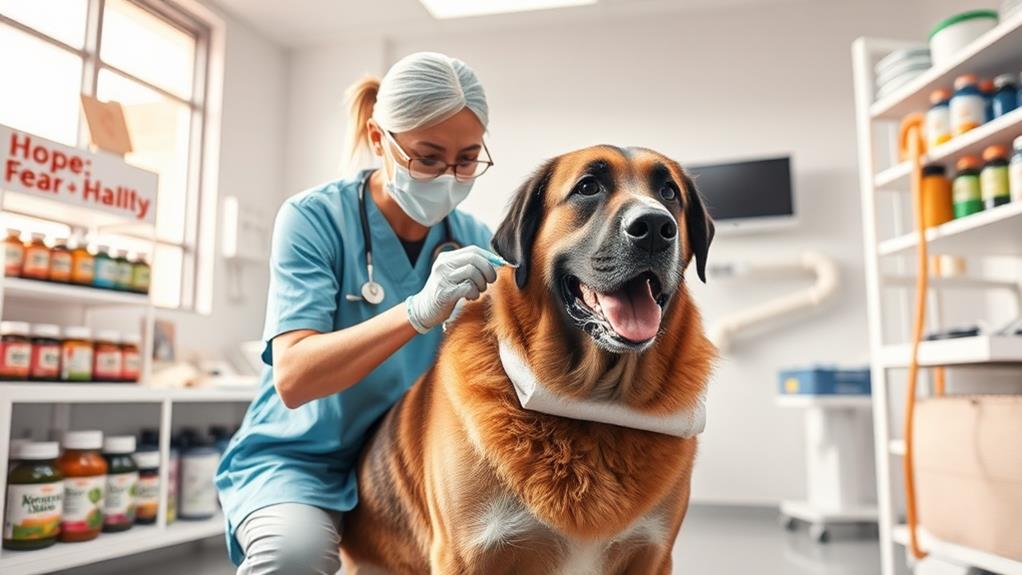
While traditional treatments have their place, innovative medications and therapies are revolutionizing how we manage canine joint discomfort. You'll find several exciting options that can help your furry friend feel better and lead a more active life.
One promising development is the use of monoclonal antibodies, which target specific inflammation pathways. These medications can provide relief without the side effects often associated with traditional non-steroidal anti-inflammatory drugs (NSAIDs). Additionally, regenerative therapies like stem cell treatment and platelet-rich plasma (PRP) therapy are gaining traction. These methods harness your dog's own healing abilities, promoting tissue repair and reducing pain.
Moreover, new nutraceuticals formulated with ingredients like green-lipped mussel and boswellia serrata can support joint health and mitigate discomfort. These supplements work at a cellular level, offering a natural alternative to pharmaceuticals.
Lastly, advancements in transdermal medications have made it easier for you to administer pain relief. These patches can deliver medication directly through the skin, ensuring consistent dosing without the stress of pills. When combined with other therapies, these innovative treatments can considerably improve your dog's quality of life. Always consult your veterinarian to find the best combination for your pet.
Weight Management Strategies

Maintaining a healthy weight is essential for your dog's joint health and overall well-being. Excess weight puts extra stress on their joints, which can lead to pain and discomfort. To help your furry friend achieve and maintain a healthy weight, consider these strategies:
- Portion Control: Measure your dog's food and stick to recommended serving sizes. Avoid free-feeding, which can lead to overeating.
- Balanced Diet: Choose high-quality dog food that's appropriate for their age, size, and activity level. Look for options that are lower in calories but high in nutrients.
- Regular Exercise: Incorporate daily walks and playtime into your routine. Aim for at least 30 minutes of moderate activity, adjusting as necessary based on your dog's ability.
- Monitor Treats: Limit treats and choose healthier options. Use treats sparingly, ensuring they don't exceed 10% of your dog's daily caloric intake.
Alternative Therapies to Explore

Exploring alternative therapies can provide valuable relief for your dog's joint discomfort. You might consider acupuncture, a practice that involves inserting thin needles into specific points on your dog's body. Many pet owners report significant improvements in their dog's mobility and pain levels after just a few sessions.
Another option is chiropractic care, which focuses on adjusting your dog's spine and joints to improve alignment and function. This therapy can enhance overall movement and reduce discomfort, making it easier for your furry friend to enjoy their daily activities.
Herbal supplements are also worth exploring. Ingredients like turmeric and green-lipped mussel have anti-inflammatory properties that may help alleviate joint pain. Always consult your vet before introducing any new supplements to guarantee they're safe and appropriate for your dog.
Massage therapy can be incredibly beneficial as well. Gently massaging your dog's muscles and joints can increase circulation, reduce stiffness, and promote relaxation. You can even learn simple techniques to do at home.
Hydrotherapy for Dogs
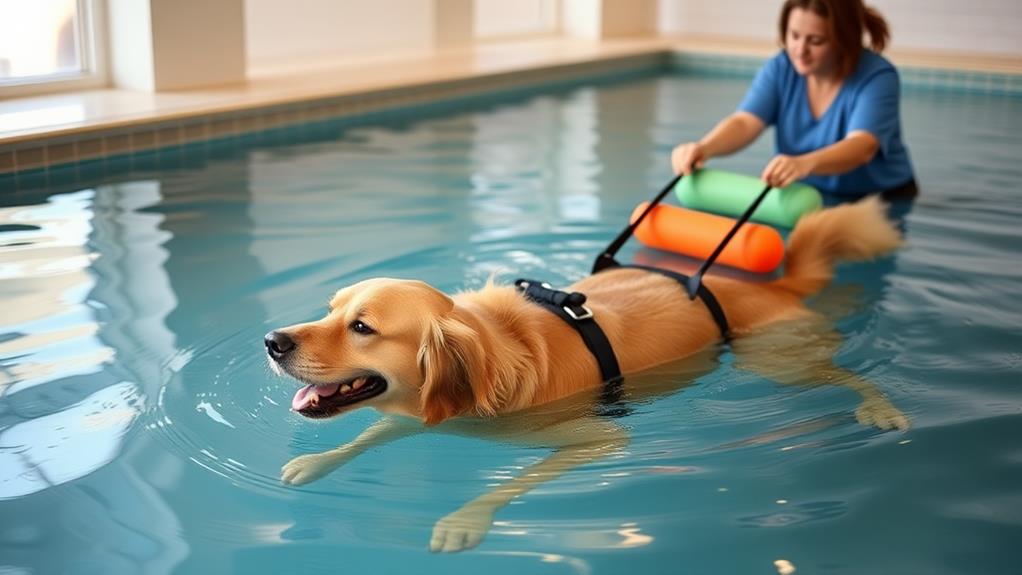
Hydrotherapy for dogs is an effective way to help alleviate joint pain and improve mobility. This low-impact exercise allows your furry friend to move without putting too much strain on their joints.
If you're considering hydrotherapy, here are some benefits you should know:
- Buoyancy Support: Water supports your dog's weight, reducing pressure on their joints and permitting easier movement.
- Increased Range of Motion: Swimming and walking in water can help enhance flexibility and strength in your dog's muscles and joints.
- Pain Relief: The warm water can soothe sore muscles and joints, providing immediate comfort to your pet.
- Controlled Environment: Hydrotherapy takes place in a safe, controlled setting, allowing for tailored exercises that suit your dog's specific needs.
Whether it's through a swimming pool designed for canines or a water treadmill, hydrotherapy can be a fun and beneficial activity for your dog. Always consult with your veterinarian before starting any new treatment to guarantee it's the right fit for your pup. With the right approach, you can help your dog regain their agility and enjoy life again!
Lifestyle Modifications for Comfort

As your dog ages or faces joint issues, making lifestyle modifications can substantially enhance their comfort and mobility. Start by evaluating your home environment. Ensuring that your living space is free from obstacles helps prevent slips and falls, which can exacerbate joint pain. Consider adding non-slip mats in areas where your dog frequents, especially on slippery floors.
Next, think about your dog's weight. Maintaining a healthy weight is vital for reducing stress on their joints. You might need to adjust their diet or increase their activity level, but always consult your vet before making changes. Short, gentle walks can boost their strength without overexerting them.
Creating a cozy resting area is also essential. Provide a supportive dog bed that cushions their joints and keeps them warm. Elevate their food and water bowls to minimize bending, making mealtime easier.
The Role of Massage Therapy

Massage therapy can be a game-changer for dogs suffering from joint discomfort. Not only does it help reduce pain, but it also promotes relaxation and improves mobility. You might be surprised at how beneficial a gentle massage can be for your furry friend.
Increased Blood Flow: Massage increases circulation, which helps deliver nutrients and oxygen to sore joints and muscles, speeding up recovery.
Reduced Muscle Tension: By working out tight spots, you can relieve tension in the surrounding muscles, making your dog feel more comfortable and agile.
Enhanced Flexibility: Regular massage can improve your dog's range of motion, allowing them to move more freely without pain.
Stress Relief: Just like humans, dogs can feel stressed. A soothing massage can help calm their nerves and create a sense of well-being.
If you want to give your dog the gift of comfort, consider incorporating massage therapy into their routine. It's a simple yet powerful way to help them feel their best and enjoy life to the fullest.
Frequently Asked Questions
What Are the Signs That My Dog Is in Joint Pain?
If your dog's limping, struggles to stand, or hesitates to jump, it's likely in joint pain. Watch for whining, excessive licking, or changes in behavior—these signs indicate discomfort that needs your attention.
How Can I Prevent Joint Discomfort in Young Dogs?
To prevent joint discomfort in young dogs, guarantee they get regular exercise, maintain a healthy weight, provide joint supplements if needed, and avoid overly strenuous activities. Regular vet check-ups can also help monitor their joint health.
Are Certain Dog Breeds More Prone to Joint Issues?
Absolutely, some dog breeds, like Great Danes and Labradors, are more prone to joint issues. Just as a castle's foundation matters, a breed's genetics can determine its strength and resilience against joint discomfort.
Can Environmental Factors Worsen My Dog's Joint Pain?
Yes, environmental factors can worsen your dog's joint pain. Cold weather, humidity, and slippery surfaces can increase discomfort. You should create a supportive environment to help alleviate their symptoms and improve their overall quality of life.
How Do I Choose the Best Vet for Joint Pain Management?
Nearly 60% of dogs over age five suffer from joint issues. To choose the best vet, consider their experience with joint pain, ask for recommendations, and guarantee they communicate well with you and your dog.
Conclusion
In the journey to ease your dog's joint discomfort, think of it as a symphony where every note matters. By blending nutritional supplements, physical therapy, and innovative treatments, you're crafting a harmonious life for your furry friend. Just like a gentle breeze brings relief on a hot day, the right combination of therapies can help your pup dance through life again. Embrace these novel approaches, and watch your canine companion wag their tail with renewed joy.



